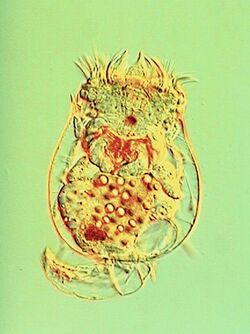Biology:Brachionus
| Brachionus | |
|---|---|

| |
| Brachionus calyciflorus | |
| Scientific classification | |
| Domain: | Eukaryota |
| Kingdom: | Animalia |
| Phylum: | Rotifera |
| Class: | Monogononta |
| Order: | Ploima |
| Family: | Brachionidae |
| Genus: | Brachionus Pallas, 1766 |
| Species | |
|
about 30 [1] | |
| Synonyms | |
|
Schizocerca Daday, 1883 | |
Brachionus is a genus of planktonic rotifers occurring in freshwater, alkaline and brackish water.
Species
Species included in Brachionus include:[2]
- Brachionus amsterdamensis De Smet, 2001
- Brachionus angularis Gosse, 1851
- Brachionus asplanchnoides Charin, 1947
- Brachionus calyciflorus Pallas, 1766
- Brachionus diversicornis (Daday, 1883)
- Brachionus havanaensis Rousselet, 1911
- Brachionus ibericus Ciros-Peréz, Gómez & Serra, 2001
- Brachionus leydigii Cohn, 1862
- Brachionus manjavacas Fontaneto, Giordani, Melone & Serra, 2007
- Brachionus nilsoni Ahlstrom
- Brachionus plicatilis Müller, 1786
- Brachionus quadridentatus Hermann, 1783
- Brachionus rotundiformis Tschugunoff, 1921
- Brachionus rubens Ehrenberg, 1838
- Brachionus urceolaris Müller, 1773
- Brachionus variabilis Hempel, 1896
Use
Rotifers such as Brachionus calyciflorus are favored test animals in aquatic toxicology because of their sensitivity to most toxicants. They also are used as model organisms in various other biological fields e.g. due to their interesting reproductive mode in evolutionary ecology. Brachionus spp. are easily reared in large numbers and because of this are used to substitute for wild zooplankton for feeding hatchery reared larval fish. However, the composition of rotifers generally does not satisfy the nutritional requirements of fish larvae,[3] and large amounts of research have been invested in improving the lipid, vitamin and mineral composition of rotifers to better meet the requirements of fish larvae[4][5][6]
Reproduction
Brachionus species can normally reproduce sexually and asexually (cyclical parthenogenesis). Sexual reproduction (termed Mixis) is usually induced when population density increases. Mixis in Brachionus plicatilis has been shown to be induced by a density-dependent chemical cue.[7]
Transitions to obligate parthenogenesis have been described in Brachionus calyciflorus. In this species, obligate parthenogenesis can be inherited by a recessive allele, which leads to loss of sexual reproduction in homozygous offspring.[8][9]In Brachionus manjavacas rotifers, offspring's survival and its cell's ability to growth and division decrease with advancing age of mother.[10]
Genome size
Haploid '1C' genome sizes in Brachionus species range at least from 0.056 to 0.416 pg.[11]
Genome sequencing
The complete mitochondrial genome of B. plicatilis sensu stricto NH1L has been sequenced.[12]
Cryptic species
Brachionus plicatilis has been demonstrated to be a large cryptic species complex consisting of several different species.[13] It has a worldwide diversity of at least 14 - 22 cryptic taxa.[14][15]
Brachionus calyciflorus also seems to be a cryptic species complex.[16]
References
- ↑ "Brachionus Pallas, 1766". National Institute for Environmental Studies. http://www.nies.go.jp/chiiki1/protoz/morpho/rotifera/r-brach1.htm.
- ↑ Segers, H. (2018). "Brachionus". WoRMS. World Register of Marine Species. http://www.marinespecies.org/aphia.php?p=taxdetails&id=134937.
- ↑ HAMRE, K.; SRIVASTAVA, A.; RØNNESTAD, I.; MANGOR-JENSEN, A.; STOSS, J. (2008). "Several micronutrients in the rotifer Brachionus sp. may not fulfil the nutritional requirements of marine fish larvae". Aquaculture Nutrition 14 (1): 51–60. doi:10.1111/j.1365-2095.2007.00504.x.
- ↑ Penglase, S; Hamre, K.; Sweetman, J.; Nordgreen, A (2011). "A new method to increase and maintain the concentration of selenium in rotifers (Brachionus spp.)". Aquaculture 315 (1–2): 144–153. doi:10.1016/j.aquaculture.2010.09.007.
- ↑ Dhert, Phillippe; Geert Rombautb; Gede Suantikaa; Patrick Sorgeloos (2001). "Advancement of rotifer culture and manipulation techniques in Europe". Aquaculture 200 (1–2): 129–146. doi:10.1016/S0044-8486(01)00697-4.
- ↑ Nordgreen, A; Penglase, S.; Hamre, K. (2013). "Increasing the levels of the essential trace elements Se, Zn, Cu and Mn in rotifers (Brachionus plicatilis) used as live feed". Aquaculture 380-383: 120–129. doi:10.1016/j.aquaculture.2012.11.032.
- ↑ Induction of sexual reproduction in Brachionus plicatilis (Monogononta, Rotifera) by a density-dependent chemical cue CP Stelzer, TW Snell - Limnology and Oceanography, 2003
- ↑ C.-P. Stelzer, J. Schmidt, A. Wiedlroither, and S. Riss (2010). Loss of Sexual Reproduction and Dwarfing in a Small Metazoan. PLoS ONE 5(9): e12854. [1]
- ↑ Scheuerl, T., Riss, S., Stelzer, C.P. (2011). Phenotypic effects of an allele causing obligate parthenogenesis in a rotifer. Journal of Heredity 102(4): 409-415. http://jhered.oxfordjournals.org/cgi/reprint/esr036?ijkey=94jzFn7JvmYfQyM&keytype=ref
- ↑ Hernández, Christina M.; Daalen, Silke F. van; Caswell, Hal; Neubert, Michael G.; Gribble, Kristin E. (2020-06-29). "A demographic and evolutionary analysis of maternal effect senescence" (in en). Proceedings of the National Academy of Sciences 117 (28): 16431–16437. doi:10.1073/pnas.1919988117. ISSN 0027-8424. PMID 32601237.
- ↑ Stelzer, C.P., Riss, S., Stadler, P. (2011) Genome size evolution at the speciation level: The cryptic species complex Brachionus plicatilis (Rotifera) BMC Evolutionary Biology 11: 90. [2]
- ↑ Koushirou Suga, David B. Mark Welch, Yukari Tanaka, Yoshitaka Sakakura, and Atsushi Hagiwara (2008). Two Circular Chromosomes of Unequal Copy Number Make Up the Mitochondrial Genome of the Rotifer Brachionus plicatilis Mol Biol Evol (2008) 25(6): 1129-1137
- ↑ Gomez, A (2002). "Speciation in ancient species complexes: evidence from the molecular phylogeny of Brachionus plicatilis (Rotifera)". Evolution 56 (7): 1431–1444. doi:10.1111/j.0014-3820.2002.tb01455.x. PMID 12206243.
- ↑ Extreme levels of hidden diversity in microscopic animals (Rotifera) revealed by DNA taxonomy D Fontaneto, M Kaya, EA Herniou… - Molecular Phylogenetics …, 2009 - Elsevier
- ↑ Diversity of the rotifer Brachionus plicatilis species complex (Rotifera: Monogononta) in Iran through integrative taxonomy Reza Malekzadeh-Viayeh1,*, Razieh Pak-Tarmani1, Nasim Rostamkhani2 and Diego Fontaneto3 Article first published online: 7 JAN 2014 DOI: 10.1111/zoj.12106
- ↑ Brachionus calyciflorus is a species complex: mating behavior and genetic differentiation among four geographically isolated strains JJ Gilbert, EJ Walsh - Rotifera X, 2005 - Springer
Huang, L. "Effectof Aldrin on Life History Characteristics of Rotifer Brachionus calyciflorus Pallas." Bull Environ Contam Toxicol no5 N 2007 Wikidata ☰ Q3516967 entry


